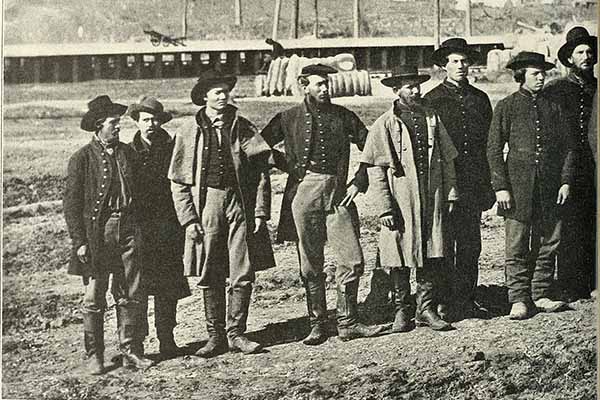CANADA HISTORY
US Civil War

During the 1850s, the United States found itself embroiled in a deepening national crisis that revolved around the issues of slavery and state sovereignty. At the heart of the conflict were two opposing ideologies: States’ Rights and Federalism. Supporters of States’ Rights believed that individual states had the authority to pass and enforce laws governing controversial issues like slavery, and they also asserted that a state had the right to secede from the Union if it disagreed with federal policies. On the other side, Federalists argued that the Federal Government had supreme authority over issues like the regulation or abolition of slavery, and that once a state joined the Union, it could not unilaterally withdraw. This disagreement, particularly concerning slavery, eventually escalated into the American Civil War (1861–1865), which would have profound repercussions not only in the United States but also in British North America.
The election of Abraham Lincoln in 1860 intensified the already volatile situation. Southern states, fearing that Lincoln's administration would move to abolish slavery, began seceding from the Union, forming the Confederate States of America by 1861. The ensuing Civil War was a defining moment in American history, but it also sent ripples across the northern border into British North America. The lessons of federalism—how a government structured around a central authority with regional representation could fail or succeed—were keenly observed by political leaders in British North America, where discussions about unification and Confederation were beginning to take shape.
By the early 1860s, the Union Army had become the largest and most experienced military force in the world, raising concerns in British North America about the threat of American expansionism. Many in British North America feared that if the Union triumphed over the Confederacy, it would turn its attention northward. The idea of Manifest Destiny—the belief that the United States was destined to expand across the North American continent—was still popular, and there was speculation that the United States might seek to annex the British colonies in Canada and the Maritimes. These concerns helped galvanize support for the unification of British North American colonies, as a larger, united political entity would be better able to resist American encroachment.
The American Civil War also triggered several incidents that strained relations between the United States and Great Britain, further exacerbating British North America's anxiety. Three incidents, in particular, underscored the precarious position of the British colonies and the importance of pursuing Confederation as a means of securing their future.
The Trent Affair
The Trent Affair of 1861 was one of the most significant diplomatic crises of the Civil War, bringing Britain and the United States to the brink of war. The Confederacy sought to gain British recognition of its independence, believing that such recognition would tip the balance of the war in its favor. To this end, two Confederate diplomats, James Mason and John Slidell, embarked on a mission to Britain aboard the British mail steamer, the Trent, after evading the Union blockade. However, on November 8, 1861, a Union warship, the USS San Jacinto, intercepted the Trent in international waters, boarded the vessel, and arrested the two Confederate envoys. The illegal seizure of a British ship sparked an intense diplomatic crisis between Britain and the United States.
In response to the Trent Affair, British forces in Canada were bolstered, with Halifax’s military garrison swelling to over 18,000 troops. Britain prepared for war, and tensions escalated dramatically. The possibility of a war between Britain and the Union loomed large, a conflict that would likely have involved the British colonies in North America. However, recognizing the futility of fighting both the Confederacy and Britain simultaneously, President Lincoln wisely chose to release the Confederate diplomats, defusing the situation. This incident, however, left a lasting impression on British North America, reinforcing the belief that the colonies would be vulnerable to American aggression if they remained divided and weak.
The Chesapeake Incident
In December 1863, another crisis unfolded with the Chesapeake Incident. A Confederate raiding party seized the Union merchant vessel Chesapeake off the coast of New York. The Confederates intended to take the ship to British waters, where they hoped to sell its cargo and refit the vessel for use in the Confederate war effort. American naval forces pursued the Chesapeake into British territorial waters and eventually recaptured the ship near Nova Scotia. The incident violated British neutrality and threatened to drag Britain into the war once again.
Although both the North and South had breached British neutrality in the Chesapeake Incident, it highlighted the vulnerabilities of British North America in the face of conflict between the Union and Confederacy. It also brought home the importance of self-defense and the need for a united front to protect British interests in North America. The realization that the region was dangerously exposed to outside forces pushed political leaders in the colonies to reconsider their fragmented state and move toward Confederation.
The St. Albans Raid
The St. Albans Raid of October 19, 1864, further fueled tensions. Confederate raiders crossed the border from Canada into Vermont and robbed three banks in the town of St. Albans, making off with a significant sum of money. The raiders then fled back across the border into Montreal. Although the Canadian authorities quickly recovered the stolen funds and returned them to the United States, the incident sparked outrage in the North. Some Union officials called for military retaliation against Canada, and there were even suggestions that Union forces should invade Montreal to capture the raiders.
Once again, President Lincoln intervened to calm the situation, recognizing that a war with Britain over Canada would be disastrous for the United States, which was already locked in a bloody conflict with the South. Nevertheless, the St. Albans Raid underscored the vulnerability of the border and the risk that conflicts in the United States could spill over into British territory. The raid provided further impetus for the colonies to unite and create a stronger defense system to prevent such incidents from escalating into a full-blown war.
The Impact of the U.S. Civil War on British North America
The American Civil War played a crucial role in shaping the political landscape of British North America in the 1860s. The immense size and power of the Union Army and the aggressive rhetoric of Manifest Destiny convinced many in British North America that their future lay in unification, not as a collection of weak, divided colonies vulnerable to American expansion. The threat of annexation or invasion became a rallying cry for those advocating Confederation.
British North America’s leaders recognized that unity would provide greater protection and a more coherent defense strategy. Confederation offered the promise of a stronger, more secure country capable of withstanding external threats, particularly from the United States. It also provided an opportunity to strengthen economic ties, enhance infrastructure like the Intercolonial Railway, and create a cohesive political system that could address the challenges of a growing nation.
By 1867, the Dominion of Canada was born, uniting the provinces of Ontario, Quebec, New Brunswick, and Nova Scotia. The lessons of the U.S. Civil War had a profound impact on the formation of Canada, reinforcing the importance of strong central governance, provincial autonomy, and the need to safeguard national security. As the United States emerged from its own civil conflict as a united but scarred nation, British North America moved forward with a new vision of Confederation, one that would allow it to forge its own path while remaining closely aligned with Britain.
Cite Article : www.canadahistory.com/sections/documents




